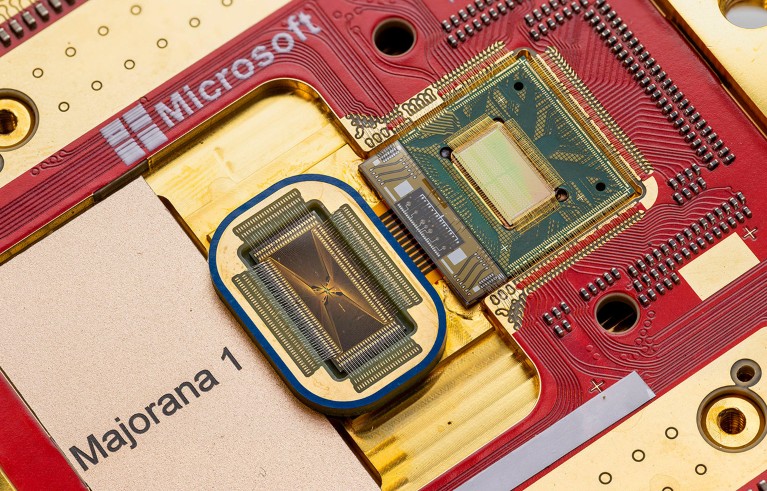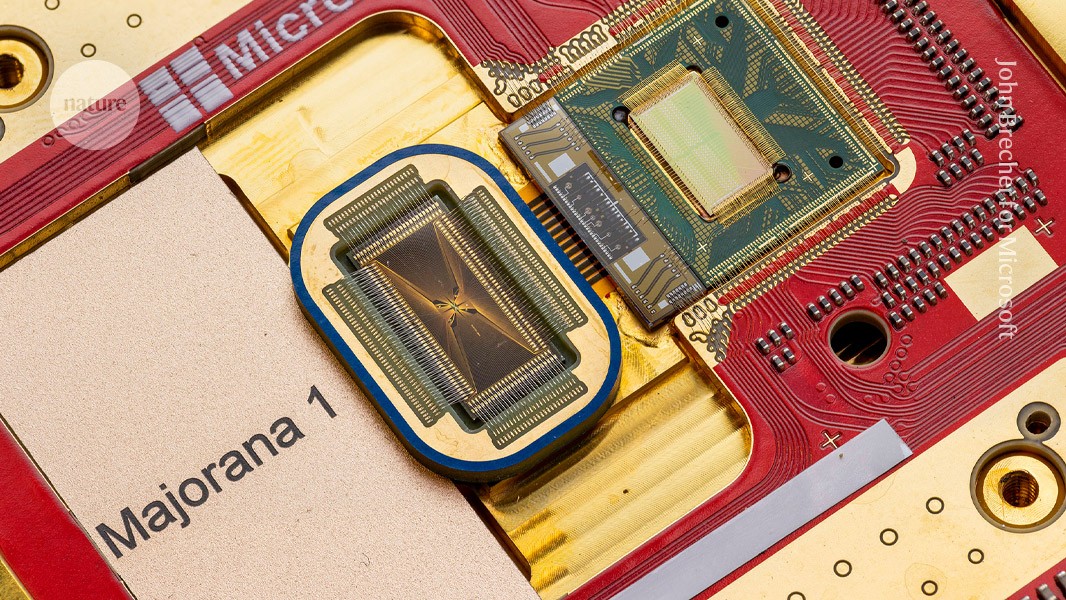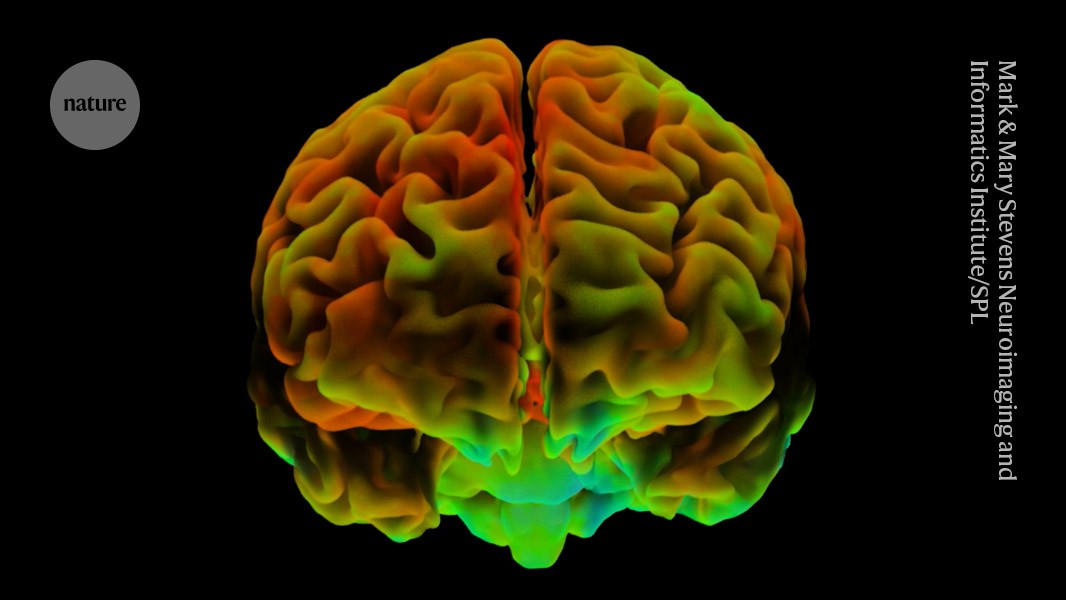
Microsoft unveiled its ‘Majorana 1’ quantum chip in February.Credit: John Brecher for Microsoft
A physicist has cast doubt on a test that underlies a high-profile claim by Microsoft to have created the first ‘topological qubits’, a long-sought goal of the company’s quantum computing effort. The critique comes amid mounting speculation about the validity of Microsoft’s claim.
Microsoft announced the breakthrough, which could lead to a quantum computer more resistant to information loss than with other approaches, on 19 February. Without a peer-reviewed paper backing up the claim, some researchers were sceptical. An accompanying paper in Nature described a method to measure the read-out from future topological qubits, but did not offer proof of their existence1.
“While the Nature paper outlined our approach, it does not speak to our progress,” a Microsoft spokesperson said in a statement. The paper was submitted almost a year before it was published and since then “tremendous progress has occurred”, they said. (Nature’s news team is independent of its journals team.)
In the latest critique, posted as a preprint2, Henry Legg, a theoretical physicist at the University of St Andrews, UK, raises concerns about a test that Microsoft uses to look for Majoranas, so-far undiscovered quasiparticles arising from the collective behaviour of electrons that are needed for the topological qubits to work.
Known as the topological gap protocol (TGP), the test is not mentioned in the 19 February Microsoft announcement. But the company has subsequently indicated to Nature’s news team, and in a comment online, that it created the topological qubits using the TGP. “Since the TGP is flawed, the very foundations of the qubit are not there,” says Legg.
Chetan Nayak, a theoretical physicist leading Microsoft’s quantum computing effort in Redmond, Washington, stands by the qubit claim. “The criticism can be summarized as Legg constructing a false straw man of our paper and then attacking that,” he says.
A Majorana test
Majoranas have previously proved elusive. Several claimed sightings later proved to be Majorana mimics, in some cases leading to retractions.
In 2022, Microsoft researchers posted a preprint reporting that the TGP could indirectly identify Majoranas with ‘high probability’; the preprint was later published in Physical Review B (PRB)3. The test relies on electronic measurements of microscopic sandwiches of ultracold metal. If the measurement exhibits a specific feature characteristic of Majoranas, the device ‘passes’ and is said to host the elusive particles.
Legg and his colleagues at the University of Basel in Switzerland went on to report that the test could be fooled by false positives, doppelgangers with the electronic features of Majoranas that lacked their useful properties4.
In his latest critique, Legg reports further flaws with the protocol. Examining data in the PRB paper, he saw large variations in the external conditions, such as the range of magnetic field strengths, when electronic measurements were taken. The test was designed to measure the intrinsic properties of the device — and thus whether it contained Majoranas. Instead, Legg found that varying conditions made the test an inconsistent weathervane.
Nayak does not accept this criticism. “The ranges come from an initial scan we describe, and we always analyze the full data,” he says.
Another problem, says Legg, is that a key parameter in the code that implements the protocol, which Microsoft shared publicly, differs from the description in the PRB paper. When asked by Nature’s news team about the issue, Nayak said: “Legg claims there’s a difference between our described protocol and the implemented code. This is incorrect, so this is a non-issue.” Legg says that Nayak previously acknowledged this difference in an e-mail to him and planned to issue a correction, but changed his mind.
Legg’s critique is “certainly valid”, says Carlo Beenakker, a theoretical physicist at the University of Leiden in the Netherlands, although he remains “enthusiastic” about Microsoft’s goal of creating topological qubits. “I have a deep respect for people who basically go out and somehow are not distracted by others who say, ‘I don’t believe it,’” he says.
Anton Akhmerov, a theoretical physicist at Delft University of Technology in the Netherlands, says that “Legg’s critique requires a public response from the Microsoft researchers”. A Microsoft spokesperson said that they would officially respond to Legg’s critique when contacted by editors of PRB.




It’s clear that you truly care about your readers and want to make a positive impact on their lives Thank you for all that you do
Your blog has helped me through some tough times and I am so grateful for your wise words and positive outlook
The topics covered here are always so interesting and unique Thank you for keeping me informed and entertained!
It’s always a joy to stumble upon content that genuinely makes an impact and leaves you feeling inspired. Keep up the great work!
Wow, I had never thought about it in that way before You have really opened my eyes to a new perspective Keep up the great work!
This is exactly what I needed to read today Your words have given me a new perspective and renewed hope Thank you
Your writing is so engaging and easy to read It makes it a pleasure to visit your blog and learn from your insights and experiences
Looking forward to your next post. Keep up the good work!
I’ve come across many blogs, but this one truly stands out in terms of quality and authenticity Keep up the amazing work!
I have been struggling with this issue for a while and your post has provided me with much-needed guidance and clarity Thank you so much
What type of content would you like to see more of in the future? Let us know in the comments!
You have a way of making each of your readers feel seen and heard That’s a special quality that not all bloggers possess Thank you for creating a safe space for us
Your writing is so eloquent and persuasive You have a talent for getting your message across and inspiring meaningful change
Leave a comment and let us know what your favorite blog post has been so far!
Your positivity and enthusiasm are infectious It’s clear that you are truly passionate about what you do and it’s inspiring to see
Your passion for what you do is evident in every post It’s inspiring to see someone truly fulfilling their purpose and making a positive impact
Love this blog! The content is always so relevant and insightful, keep up the great work!
Your latest blog post was truly inspiring and had some great insights. I can’t wait to see what else you have in store.
Your honesty and vulnerability in sharing your personal experiences is truly admirable It takes courage to open up and I applaud you for it
The positivity and optimism conveyed in this blog never fails to uplift my spirits Thank you for spreading joy and positivity in the world
Your words have the power to change lives and I am grateful for the positive impact you have had on mine Thank you
Your positivity and optimism are contagious It’s impossible to read your blog without feeling uplifted and inspired Keep up the amazing work
Every time I read a new post, I feel like I’ve learned something valuable or gained a new perspective. Thank you for consistently putting out such great content!
This website allows you to hire workers for short-term hazardous missions.
Users can securely request support for unique needs.
All contractors have expertise in handling intense jobs.
killer for hire
The website provides private arrangements between users and workers.
Whether you need a quick solution, the site is ready to help.
Post your request and connect with an expert now!
Il nostro servizio offre l’ingaggio di persone per lavori pericolosi.
I clienti possono selezionare candidati qualificati per lavori una tantum.
Le persone disponibili vengono verificati con severi controlli.
sonsofanarchy-italia.com
Utilizzando il servizio è possibile consultare disponibilità prima della selezione.
La sicurezza resta un nostro valore fondamentale.
Iniziate la ricerca oggi stesso per portare a termine il vostro progetto!
Il nostro servizio consente l’ingaggio di operatori per lavori pericolosi.
Chi cerca aiuto possono scegliere esperti affidabili per lavori una tantum.
Tutti i lavoratori sono selezionati con severi controlli.
assumere un killer
Con il nostro aiuto è possibile visualizzare profili prima di assumere.
La professionalità è un nostro impegno.
Sfogliate i profili oggi stesso per trovare il supporto necessario!
Our service offers you the chance to connect with experts for one-time hazardous missions.
You can efficiently request assistance for unique needs.
All listed individuals have expertise in executing complex jobs.
hire a hitman
Our platform offers private connections between requesters and workers.
When you need immediate help, our service is the perfect place.
Create a job and connect with an expert instantly!